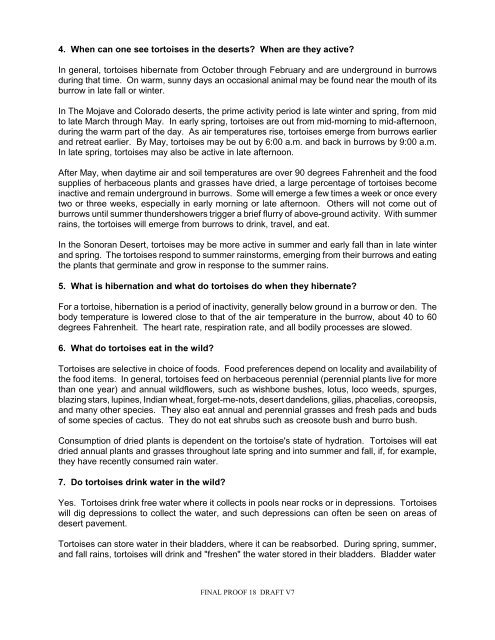Answering Questions About Desert Tortoises - Desert Managers ...
Answering Questions About Desert Tortoises - Desert Managers ...
Answering Questions About Desert Tortoises - Desert Managers ...
Create successful ePaper yourself
Turn your PDF publications into a flip-book with our unique Google optimized e-Paper software.
4. When can one see tortoises in the deserts? When are they active?In general, tortoises hibernate from October through February and are underground in burrowsduring that time. On warm, sunny days an occasional animal may be found near the mouth of itsburrow in late fall or winter.In The Mojave and Colorado deserts, the prime activity period is late winter and spring, from midto late March through May. In early spring, tortoises are out from mid-morning to mid-afternoon,during the warm part of the day. As air temperatures rise, tortoises emerge from burrows earlierand retreat earlier. By May, tortoises may be out by 6:00 a.m. and back in burrows by 9:00 a.m.In late spring, tortoises may also be active in late afternoon.After May, when daytime air and soil temperatures are over 90 degrees Fahrenheit and the foodsupplies of herbaceous plants and grasses have dried, a large percentage of tortoises becomeinactive and remain underground in burrows. Some will emerge a few times a week or once everytwo or three weeks, especially in early morning or late afternoon. Others will not come out ofburrows until summer thundershowers trigger a brief flurry of above-ground activity. With summerrains, the tortoises will emerge from burrows to drink, travel, and eat.In the Sonoran <strong>Desert</strong>, tortoises may be more active in summer and early fall than in late winterand spring. The tortoises respond to summer rainstorms, emerging from their burrows and eatingthe plants that germinate and grow in response to the summer rains.5. What is hibernation and what do tortoises do when they hibernate?For a tortoise, hibernation is a period of inactivity, generally below ground in a burrow or den. Thebody temperature is lowered close to that of the air temperature in the burrow, about 40 to 60degrees Fahrenheit. The heart rate, respiration rate, and all bodily processes are slowed.6. What do tortoises eat in the wild?<strong>Tortoises</strong> are selective in choice of foods. Food preferences depend on locality and availability ofthe food items. In general, tortoises feed on herbaceous perennial (perennial plants live for morethan one year) and annual wildflowers, such as wishbone bushes, lotus, loco weeds, spurges,blazing stars, lupines, Indian wheat, forget-me-nots, desert dandelions, gilias, phacelias, coreopsis,and many other species. They also eat annual and perennial grasses and fresh pads and budsof some species of cactus. They do not eat shrubs such as creosote bush and burro bush.Consumption of dried plants is dependent on the tortoise's state of hydration. <strong>Tortoises</strong> will eatdried annual plants and grasses throughout late spring and into summer and fall, if, for example,they have recently consumed rain water.7. Do tortoises drink water in the wild?Yes. <strong>Tortoises</strong> drink free water where it collects in pools near rocks or in depressions. <strong>Tortoises</strong>will dig depressions to collect the water, and such depressions can often be seen on areas ofdesert pavement.<strong>Tortoises</strong> can store water in their bladders, where it can be reabsorbed. During spring, summer,and fall rains, tortoises will drink and "freshen" the water stored in their bladders. Bladder waterFINAL PROOF 18 DRAFT V7
















